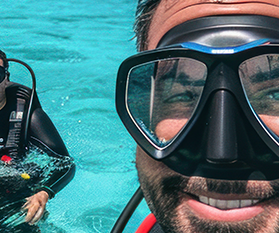Asking Questions is an Education
AND SOMETIMES THE ANSWERS ARE A PLEASANT SURPRISE A common mistake is for a company to think they own their brand. Most management books will tell you that’s wrong. A brand isn’t the sum of the logo, the company colour scheme, its mission statement or value proposition. A brand is something that lives in the mind of its audience… its customers. With that in mind, from time-to-time we ask our members — the professionals who teach for us, and the folks they teach — to reinforce what RAID represents to them. What we tell ourselves, the ‘water cooler talk,’ around the office, is that RAID is about safety. And of course it is, but the answers we get from the people in the outside community are a little different. To them RAID stands for competence because that’s what we teach; sincerity because that’s how our instruction comes across to them; integrity and consistency because both those character traits are part of our training philosophy. They also talk about reliability because they’ve learned to trust RAID pros to know their stuff and get the right message across during EVERY RAID course. All this is really encouraging. But what tops it all, they tell us the most important thing is trust. They trust RAID because it’s fair, it’s safe, it’s inclusive, and it’s real. We don’t like to boast, but that made our day.
There’s a bit more to it than gas
FACTORS THAT INFLUENCE GETTING ‘NARCED’ Every beginner’s dive class introduces its students to the topic of nitrogen narcosis: the anesthetic effect of certain gases particularly nitrogen, when breathing compressed air or other gas mixtures under high pressure. It’s an important piece of info. In many ways, critical knowledge for any level of diving. However, for the most part, initial discussion, even in some advanced recreational courses, is pretty basic stuff. It’s just enough to scratch the surface of what is a complex and nuanced topic. And the proof of just how basic is right there in the name. What tends to be overlooked, is that although nitrogen partial pressure is the trigger, there are a bunch of factors other than it playing an important role in magnifying the effects of being ‘narced.’ The confusion begins when we try to define where it starts: that is, what depth represents the threshold between being okay and feeling the effects of narcosis. That boundary is far from fixed. As with so much related to physiology, it varies from person to person. Even more frustrating when we try to find a hard edge between fine and fudged, is that it also varies from day-to-day. That’s to say, diver A may feel nothing on a dive on day one of a trip and be close to incapacitated on day two while doing the same dive to the same depth. Because of this, most agencies, RAID included, publish a conservative depth/partial pressure guideline: conservative but possibly misleading because by definition nitrogen load, which is what depth considers, makes no specific mention of the contributions of alcohol, fatigue, task-loading, anxiety, and hypothermia, which are each said to have a synergistic effect. Another factor is the additive effects of carbon dioxide buildup in the blood. This latter coming from both incorrect/rapid breathing or the actual work of breathing at depth due to poorly designed scuba regulators or those in need of servicing and a tune-up. So, there’s much more to it than nitrogen… it pays to be fully aware of just how much more. HOW IT FEELS, WHAT IT DOES – Euphoria, similar to alcohol intoxication. – Impaired judgment, confusion, and difficulty concentrating. – Slowed reaction times and reduced coordination. – In severe cases, hallucinations or unconsciousness. – Symptoms typically worsen with increasing depth. DEPTH THRESHOLD – Narcosis usually becomes noticeable at depths greater than 30 meters (100 feet), though susceptibility varies among individuals. – Symptoms intensify as depth increases, with severe impairment, in colder water and under stress, often occurring beyond 40-50 meters (130-165 feet). RISK FACTORS – Deeper dives increase the risk. – Cold water, stress, fatigue, and alcohol consumption can exacerbate symptoms. – Individual susceptibility varies; some divers are more prone to narcosis than others. MANAGEMENT – Limit dive depth to reduce the risk of narcosis. – Use gas mixtures with lower nitrogen content, such as nitrox (higher oxygen, lower nitrogen, but the jury is not totally decided on the efficacy of this particular strategy) or trimix (helium, oxygen, and nitrogen although this is unavailable or prohibitively expensive in many regions). – Avoid rapid descents and allow time for the body to adapt to pressure changes. – Stay calm and avoid overexertion during the dive. – If symptoms occur, ascend to a shallower depth, where the effects will diminish. – Communicate with your dive buddy and monitor each other for signs of impairment. – Abort the dive if symptoms are severe or unmanageable. LONGTERM EFFECTS – Inert gas narcosis is temporary and resolves upon ascending to shallower depths or surfacing. – There are no long-term effects if managed properly, but repeated or severe episodes can increase the risk of diving accidents. CONCLUSION Inert gas narcosis is a well-known risk in deep diving, but it can be managed through proper training, depth limits, and gas mixture selection. Divers should be aware of the symptoms and take precautions to ensure safety during deep dives.
Monthly Specials
FEB/MARCH 2025 — VERSATILE SIDEMOUNT Learn to fly sidemount with the experts. RAID’s sidemount specialty is one of the most popular and something the agency is famous for… RAID has early bragging rights! If you’re ready to add this to your scuba adventure, you’ve come to the place: the place where it all started. The foundation of any new skill is to start the journey learning from comprehensive manuals and challenging quizzes. Students tell us our online course is excellent on both counts. That’s no surprise really, our sidemount specialty materials and standards were created by SMEs* who have been diving and teaching open-circuit sidemount for a couple of generations in conditions as diverse as under the ice in eastern Canada to caves under the Mexican jungle, the wrecks of Truk Lagoon and coral canyons off the Philippines. They know their stuff, and after a RAID sidemount specialty course, so will you. Typically, once a student has completed the online work, their chosen instructor will conduct an academic session in the classroom, covering the relevant theory and various techniques and alternate configurations in detail. Following this there will be a comprehensive equipment workshop. The focus will be on the best options to deal with local dive conditions and kit demands (such as drysuits or dive skins). At this stage, students will learn about all necessary equipment, how to assemble it, and how to make adjustments to fit their body type and the demands of the local environment. This segment will be followed by skills development in confined water and then it’s off to the final open water checkout dives. To start your new adventure, start your course via RAID FREe-Learning and then contact your local RAID Dive Centre >>> *SME is the abbreviation used to describe a subject matter expert. At RAID, this is most often an experienced dive professional
Diving is Risky Business
RAID’s UNIQUE QA SYSTEM HELPS… Playing in water can be dangerous. There are risks associated with diving of every description. This is something we have to accept and learn to deal with if we want to go diving. The goal of any RAID instructor is to deliver this message, but, more importantly, it’s to dive students the knowledge, skills, and techniques to manage those risks. Making them disappear is impossible. The best any of us can do is to identify, mitigate, and avoid, but risk is always a factor to consider. RAID professionals are chosen to represent the agency and to deliver the RAID brand of training for many reasons: skill, empathy, knowledge, spirit, desire. These traits are probably shared by the majority of instructors across the diving industry, but we try to go further. In part, student safety is a function of standards and sticking to them. RAID’s standards exceed by far the minimums accepted as ‘good enough’ across the industry. Shortcuts, courses that are hurried and packed to the maximum possible, are discouraged and policed heavily. RAID students, every one of them, takes part in that process by default. They are required to complete a questionnaire about their training as part of the final course assessment. That is 100 percent of students, not a select few. RAID cannot guarantee student safety, no agency can, but we come closer than most to being able to make that promise.
What does RAID stand for…

A REMINDER FROM WHEN DRI WAS FORMED Regardless of whether you are a student taking your first breathe underwater, or a professional instructor teaching every specialty RAID offers, it is really important to understand what your training agency stands for. In other words, what are its core beliefs and how do they influence how you will progress as a diver, a dive professional, or a dive shop owner and operator? First off, RAID is a diving agency for divers, by divers. Like you, our love of the water knows no bounds. The people who work at RAID are not office clerks and bean counters… they are divers. This means that no matter what role that person plays at the agency, they are focused on making the experience fun, safe, technologically advanced and as inclusive as possible for our members and their students. Our vision is to be the benchmark brand for quality dive training globally through improved technology, training techniques, a proactive quality control system and ensuring the highest standard of dive instruction. The measure of our success is not the number of divers we train but the quality of the divers we help to create. Every diver we train is an ambassador for RAID. Our Mission is simple and based on that vision: RAID believes in the application of technology, superior yet inclusive instruction and environmental responsibility to improve the quality, enjoyment, and safety of the scuba experience for a new generation of divers. RAID FOR DIVERS | RAID FOR DIVE PROS | RAID MEANS OPPORTUNITIES FOR BUSINESS GROWTH ORIGINALLY PUBLISHED IN JANUARY 2022.
January RAID Special

NITROX IS THE ANSWER Signing up for a nitrox class seems to be a no-brainer to some divers; they understand the benefits right away and have no hesitation taking the plunge and enjoying the benefits. But perhaps a fair percentage of these are the lucky ones whose instructors offered nitrox training as part of their open water training. And certainly, that’s a great place to start. However, others may take a little more convincing. Whichever camp one is in, the simple fact is that the introduction of nitrox — essentially refined compressed air with a carefully measured ‘squirt’ of extra oxygen taking the place of some nitrogen — is one of the greatest, most innovative advances in recreational diving of the modern era. It’s right up there with late-generation personal dive computers and online learning. There are all the well documented benefits: Extended Bottom Time: Reduced Decompression Stress: Less Post-Dive Fatigue: Shorter Surface Intervals, and so on. But as well as nitrox helping to expand one’s diving opportunities, the RAID course teaches valuable skills that make for more knowledgeable divers, which we think means better divers. These ‘extra’ skills include tighter attention to dive planning, careful equipment choices, gaining a better understanding of gas toxicity and contaminants, and learning how to analyse and label diving gases (an essential step in safe diving practices). Your local RAID Dive Centre can explain how nitrox can make your diving a valuable investment to enhance your diving safety, enjoyment, and opportunities. And if you are already a nitrox user, ask about NITROX PLUS.
How To Be A Better Diver

THERE’S ABSOLUTELY NO SECRET… IT’S LIKE PLAYING PIANO! When it comes to scuba diving, there’s no such thing as being a natural. Same thing goes for rebreather diving and freediving. There are folks who seem to have zero problem being relaxed in the water. And these are the ones who manage to look like they know what they are doing: always. These are the people who look natural, and make it all seem so amazingly easy. But look closely and you’ll find out that to get that way, they had to work at it just like the rest of us. Probably the question most frequently asked of experienced divers — the people who look like naturals — is, ‘HOW?’ How do you make it look so easy and why does it look like your dive gear is painted on? Well, the answer is simple and universal. One of our RAID cave instructor-trainers summed it up perfectly. When asked how long it took her to learn to do the reverse frog kick so well. She, thought for a moment and answered, “about 23 years. Since I first learned to dive. And I think I’m starting to get the hang of it.” Diving, at least making it look natural and easy, comes with hours in the water. It’s not about how many classes you’ve taken or how deep you go or how much gear you own. It’s all related to time. And although exactly how much time does seem to vary from person-to-person (some get it in a few hours while others take a ‘little’ longer), the secret is getting in the water and diving. And more to the point, it’s about diving with a purpose. When you’re trying to bring your game up to a higher level, dive with the goal in mind. Build on the basic skills you picked up in class. Focus on the fundamentals, buoyancy, trim, breath-control, situational awareness. RELAX. Hit your favourite dive spot, and keep it simple. Use a pool if one’s available. Most of all, steal the technical diver’s habit of practicing skills at the end of EVERY dive. Run through the basics, from regulator shutdowns to mask removal: the most complex to the simplest. They all count, and it’s guaranteed that you will benefit from the practice. Think of it as learning the scales for those early childhood piano lessons that we all “LOVED”. Before you know it, you’ll be playing Chopin like a pro. TELL US WHAT SKILL YOU HATE DOING MOST!
So, What Now?

HERE’S WHAT TO DO AFTER EARNING YOUR RAID OW20 The most important thing and the best advice is ‘Go Diving!’ Graduates from a RAID open water course have the basic skills to enjoy basic scuba diving and have fun doing it. Although we’d love to have you sign up for a specialty course right way, it’s far better for you to get a little experience logged with a dive buddy. In essence, to go our and have some fun. Just remember to “Keep it real, stay within your comfort zone, and stay safe.” When the time comes to broaden your understanding and knowledge, speak to your RAID instructor about next steps. A lot will depend on where you dive and what’s available in your area, or if you have dive travel in mind and what to take the adventure on the road. The list of possibilities is long. Take a look at our FREe-Learning if you haven’t already checked it out. Do a little research and you’re sure to find something to interest you and help you progress at your speed. However, one course we do recommend is NITROX. Most divers find diving with nitrox has several real advantages over plain air. In any event, congrats and do keep diving. This is a water world.
Static Apnea Special

WHY BREATH-HOLDING IS IMPORTANT TO SCUBA DIVERS This month, RAID is shining a spotlight on the benefits of static apnea training for scuba divers. Odd that something divers are told NOT to do — hold their breath — can offer such a long list of rewards. Static apnea is listed as a freediving discipline where a person holds their breath underwater for as long as possible without swimming or moving around. As a stand-alone skill, it is a competitive category for freediving. However, static apnea training can offer several benefits for scuba divers too, enhancing their overall diving experience and safety. And the added bonus is that Static Apnea training is available from most RAID instructors because we feel it is such an important and fundamental skill that sits at the very core of being comfortable and ‘at one’ with the water. Here are some key advantages: So, incorporating static apnea training into a diver’s routine can provide substantial advantages, not only in their diving skills but also in ensuring a safer and more enjoyable experience.
Decompression Diver
WHEN YOU DON’T WANT TO LEAVE THE PARTY EARLY RAID’s new advanced diving course has been engineered to be a soft introduction to staged decompression diving: it’s a simple but open-ended entry point into all the excitement and challenge of technical diving. This is Sidemount or Twinset diver course. This course allows for dives up to 40 meters /130 feet using three cylinders. This includes two filled with bottom gas (twinset or sidemount see below), and one with.decompression gas. The decompression gas for this course can contain a maximum of 100 percent oxygen when conditions are suitable with minimum of 50 percent recommended. Prerequisites to join this course are for students to be 18 or older, and to be an experienced open water divers with 30 hours/25 hours or more logged underwater with Deep, Nitrox (or Nitrox Plus), and Explorer 30 or Advanced 35 specialties. Decompression diver showcases RAID’s different approach to deep diving, and introduces students to more complex dive planning, the benefits of using a dedicated decompression gas. and smooth team work before, during, and post adventure. The Decompression Diver course may be combined with either sidemount or twinset training and cert cards will be configuration specific. During 2025 rollout phase RAID Deco 40 instructors or higher may conduct the Decompression Diver course. Limited Trimix may be conducted by Deco 40 Trimix instructors or higher. Each student must complete these requirements.

